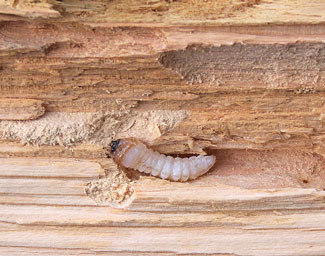“Old House Borers” Infest New Houses
By Chris Williams on June 23, 2014.

Old house borer larva

Adult old house borer beetle
Despite its name, the wood-boring beetle known as the old house borer is not generally a pest of old homes. It’s mostly found in houses less than 10 years old.
The old house borer is what we call a long-horned beetle (it has really long antennae) and its wood-boring larvae can be a serious structural pest in the eastern half of the U.S. The adult beetle is about one inch long and mostly dark gray. In homes, adult beetles can be found on or near infested wood, or at nearby windows or lights.
Wood is Usually Infested Before Construction
The beetles attack seasoned pine, fir, or spruce framing lumber or joists; never hardwood. The female beetle lays her eggs in cracks in felled logs or in wood stored in lumberyards. The beetle infestation is literally built into the home when it is constructed. Infestations can occur anywhere in a building — in walls, attics, basements, or crawlspaces — usually in wood that is thicker than one inch.
The beetle larvae that hatch from the eggs feed inside the wood for 2-7 years, although the larval stage can last as long as 15 years. The larvae leave wide galleries or tunnels as they move through the wood, feeding. When full grown, the grub-like larvae are about 1-1/4 inch long and creamy white in color. You can actually hear them feeding in the wood, making scratching, clicking, or rasping sounds. After the larvae pupate, adult beetles begin emerging from the wood in June-August. When they chew their way out of the wood, the beetles leave a distinctive ¼ inch diameter oval exit hole.
How Do You Know if the Infestation is Active?
You usually can’t tell if wood is infested by old house borers by looking at the outside. If adult beetles have already emerged, you can see their oval exit holes. If there are no exit holes, you would have to break open a piece of infested wood to see the larvae inside their tunnels. The walls of the tunnels are grooved from the larva’s jaws. The tunnels also contain a sawdust-like material called frass which is digested wood.
Finding old house borer exit holes in wood doesn’t mean there is currently an active infestation. If all of the adult beetles have emerged, the infestation may have ended. However, the old house borer is one of the wood-infesting insects that can reinfest wood in a home. This happens most often in areas where there is excessive wood moisture, like in attics with leaky roofs.
If you think your home might be infested with old house borers, you need to contact a professional exterminator who can positively identify the pest, determine the extent of the infestation, and treat infested wood to kill feeding larvae. Give Colonial Pest a call.
Larva photo: By Rasbak (Own work) [GFDL or CC-BY-SA-3.0], via Wikimedia Commons
Adult beetle photo: By Siga (Own work) [GFDL or CC-BY-SA-3.0-2.5-2.0-1.0], via Wikimedia Commons